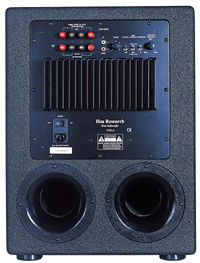Hsu Research VTF-3 powered subwoofer
 The first Hsu models had tall, cylindrical cabinets and downfiring drivers, a design that, according to Poh Ser Hsu, has some inherent advantages over the more conventional rectangular box with forward-firing driver. However, the market for these strange-looking subs was limited, and while they remain available, Hsu eventually had to face the fact that, if he wanted to sell more subwoofers, he had to come out with designs that were more domestically acceptable. The $499 VTF-2, which I reviewed very favorably in the December 1999 SGHT, was the first of these more conventional designs. The VTF-3 is described as the VTF-2's "more powerful 12-inch cousin."
The first Hsu models had tall, cylindrical cabinets and downfiring drivers, a design that, according to Poh Ser Hsu, has some inherent advantages over the more conventional rectangular box with forward-firing driver. However, the market for these strange-looking subs was limited, and while they remain available, Hsu eventually had to face the fact that, if he wanted to sell more subwoofers, he had to come out with designs that were more domestically acceptable. The $499 VTF-2, which I reviewed very favorably in the December 1999 SGHT, was the first of these more conventional designs. The VTF-3 is described as the VTF-2's "more powerful 12-inch cousin."
Description and Design
The VTF-3 is a fairly big box (20 by 15 by 22 inches), with what the product literature describes as a "beautiful, elegant, and unobtrusive black finish with rounded edges and corners." The finish is certainly black, and the edges and corners are indeed rounded, but I wouldn't describe the VTF-3 as "beautiful" or "elegant." "Utilitarian" is more like it, at least compared to the glossy black of the Velodyne HGS subs—but I agree that the Hsu's appearance is unobtrusive. The box is obviously very solid in construction, and I'm told it has bracing between the top, bottom, and side panels, placed asymmetrically to reduce enclosure resonances.
The 12-inch driver weighs 20 pounds, has a 120-ounce magnet, and features a rubber surround and a poly-cotton spider. It's driven by a 250W amplifier designed specifically for subwoofer duty, and the adjustable (lowpass only) crossover can be bypassed. A phase switch selects 0° or 180°, and a signal-sensing circuit turns the amplifier on and off automatically.
Like the VTF-2, the VTF-3 has two rear ports (side-firing on the VTF-2, rear-firing on the VTF-3), flared to minimize port noise. Stuffing one of these with the supplied foam plug and selecting "20Hz" on a toggle switch puts the subwoofer in its Maximum Extension mode, recommended for the reproduction of music that has very deep bass. Removing the plug and changing the switch to the "25Hz" position selects the Maximum Output mode, said to produce more output with less distortion while giving up some extension in the process. This mode is recommended for most home-theater applications.
 Dialing In the Performance
Dialing In the Performance
I placed the VTF-3 just slightly out from the left front corner of my home-theater room, a position that has worked well with a variety of subwoofers. With the VTF-2, I had also tried the behind-the-listening-seat placement favored by Poh Ser Hsu, and, as he predicted, that position produced even better performance. However, for me (and, I suspect, most people who have priorities in life other than optimizing subwoofer performance) that position is just not practical. For this reason, and to provide consistency with my other subwoofer reviews, I left the VTF-3 in the front corner position.
I connected the VTF-3 to the subwoofer output of the Anthem AVM-20 surround preamp-processor, set the processor's crossover to 80Hz, and bypassed the Hsu's built-in crossover. I initially set the VTF-3's level using the AVM-20's calibration signals and my trusty RadioShack SPL meter, which I placed on a small tripod at the central listening seat.
I had preferred the sound of the VTF-2 in Maximum Extension mode, and I assumed that my preference would be the same with the VTF-3, so I kept the port plugged and left the switch in the 20Hz position. I used the VTF-3 this way for a while, mostly watching DVDs. This setup seemed to work well enough, but at times there was some bass heaviness that I didn't think was part of the program material. Some more tweaking was called for.
One feature of Infinity's latest series of subwoofers (I reviewed the IL120S in the November 2001 Guide) is their Room Adaptive Bass Optimization System (R.A.B.O.S.). This consists of a CD with 23 test tones covering the 20-100Hz range, a custom SPL meter designed and calibrated for testing bass response, and controls on the subwoofer to minimize any measured peak in the bass region. Although the VTF-3 has no similar controls, I thought I could use the measurement part of R.A.B.O.S. to check out the Hsu's response and then make whatever adjustments were available to optimize it.
Placing the R.A.B.O.S. SPL meter at the listening position and playing the test CD revealed that the response from 100Hz through the 80Hz crossover region was fairly flat, but there was a peak of about 6dB in the 40-38Hz region, followed by recovery to the same level as 100Hz from 30 to 24Hz, and then a 10dB peak in the 22-20Hz region. No wonder the bass seemed heavy! Although the standard calibration using the surround processor's subwoofer test signal indicated a good level match between sub and main speakers, R.A.B.O.S. revealed that the match was far from optimal.
- Log in or register to post comments



































































